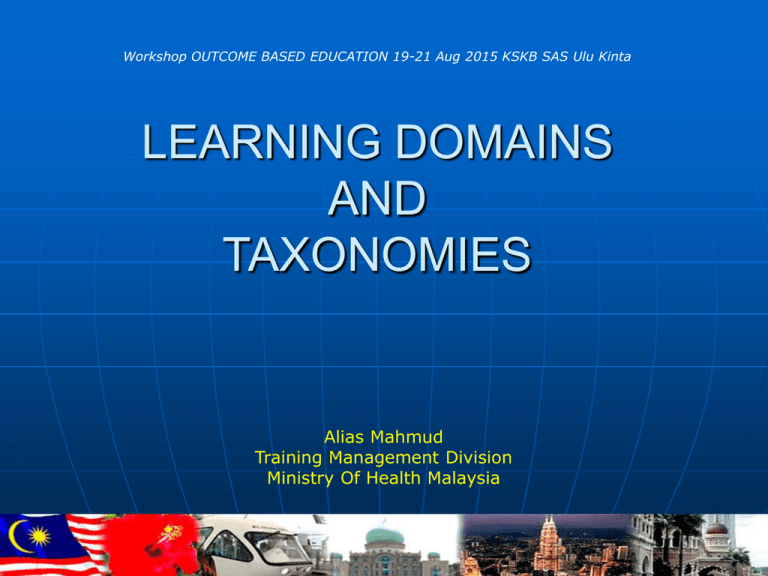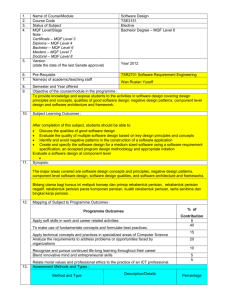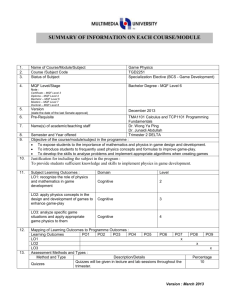Learning Domains & Taxonomies: Outcome Based Education
advertisement

Workshop OUTCOME BASED EDUCATION 19-21 Aug 2015 KSKB SAS Ulu Kinta LEARNING DOMAINS AND TAXONOMIES Alias Mahmud Training Management Division Ministry Of Health Malaysia Teacher Centered Student Centered LEARNING DOMAINS The three domain of learning: • Cognitive • Affective, and • Psychomotor 8 MQF Learning Outcome Domains 1 2 Knowledge 3 4 5 Values, attitudes and professionalism 6 7 Problem solving and scientific skills 8 KPSVCPIM Social skills and responsibilities Practical Skills Communication, leadership and team skills Information management and lifelong learning skills Managerial and entrepreneurial skills MQF & MOHE Learning Outcome Domains MQF MOHE Knowledge Knowledge Practical Skills Practical Skills Social Skills and Responsibilities Thinking and Scientific Skills Values, Attitudes and Professionalism Communication Skills Communication, Leadership and Team Skills Social Skills, Team work and Responsibilities Problem Solving and Scientific Skills Values, Attitudes and Professionalism Information Management Skills and Lifelong Skills Information Management Skills and Lifelong Skills Managerial and Entrepreneurial Skills KPSVCPIM Managerial and Entrepreneurial Leadership Skills MATRIKS LEARNING OUTCOMES VS MQF LEARNING OUTCOMES Learning Outcomes MQF Learning Outcomes Domain MQF1 MQF2 MQF3 MQF4 Demonstrate fundamental knowledge in medical and health sciences Demonstrate competence in patient centered care incorporating socio-culture and caring values Demonstrate sensitivities and responsibilities towards the community, culture, region and environment Adhere to legal, ethical principles and the professional code of conduct in medical and health sciences MQF1: MQF2: MQF3: MQF4: MQF5: MQF6: MQF7: MQF8: Knowledge Practical skills Social skills and responsibilities Values, attitude and professionalism Communication, leadership and team skills Problem Solving and Scientific skills Information Management and lifelong learning skills; and Managerial and entrepreneurial skills MQF5 MQF6 MQF7 MQF8 Change in Terms Categories noun to verb • Taxonomy reflects different forms of thinking (thinking is an active process) verbs describe actions, nouns do no Reorganized categories • Knowledge = product/outcome of thinking (inappropriate to describe a category of thinking) now remembering • Comprehension now understanding • Synthesis now creating to better reflect nature of thinking described by each category Handout # Remembering The learner is able to recall, restate and remember learned information • • • • • • • • Describing Finding Identifying Listing Retrieving Naming Locating Recognizing What happened after...? How many...? What is...? Who was it that...? Name ... Find the definition of… Describe what happened after… Who spoke to...? Which is true or false...? Can students recall information? Understanding Student grasps meaning of information by interpreting and translating what has been learned • • • • Classifying Comparing Exemplifying Explaining • • • • Inferring Interpreting Paraphrasing Summarizing Explain why… Write in your own words… How would you explain…? Write a brief outline... Who do you think...? What was the main idea...? Clarify… Illustrate… Can students explain ideas or concepts? Applying Student makes use of information in a context different from the one in which it was learned • Implementing • Carrying out • Using • Executing Explain another instance where… Which factors would you change if…? What questions would you ask of…? From the information given, develop a set of instructions about… Can students use the information in another familiar situation? Analyzing Student breaks learned information into its parts to best understand that information • • • • • • • • Attributing Comparing Deconstructing Finding Integrating Organizing Outlining Structuring If. ..happened, what might the ending have been? How is...similar to...? What do you see as other possible outcomes? Why did...changes occur? Explain what must have happened when... What are some or the problems of...? Distinguish between... What were some of the motives behind..? What was the turning point? Can students break information into parts to explore understandings and relationships? Evaluating Student makes decisions based on in-depth reflection, criticism and assessment • • • • • • • • Checking Critiquing Detecting Experimenting Hypothesising Judging Monitoring Testing Judge the value of... What do you think about...? Defend your position about... Do you think...is a good or bad thing? How would you have handled...? What changes to… would you recommend? How effective are...? What are the consequences...? What influence will....have on our lives? What are the pros and cons of....? Why is....of value? What are the alternatives? Can students justify a decision or a course of action? Creating Student creates new ideas and information using what previously has been learned • • • • • • • Constructing Designing Devising Inventing Making Planning Producing Design a...to... If you had access to all resources, how would you deal with...? Design your own way to... How many ways can you...? Create new and unusual uses for... Develop a proposal which would... Can students generate new products, ideas, or ways of viewing things? AFFECTIVE DOMAIN (Krathwohl Model) Revise, require, rate, avoid, resist, manage, maintain Discuss, synthesizes, organize, formulate, balance, prioritize, combine Measure, demonstrate, appreciate, support, debate Comply, follow, commend, volunteer, engage in Differentiate, accept, listen for, respond to, locates, point to PSYCHOMOTOR DOMAIN (Simpson’s Model) Creating new movement patterns to fit particular situation Skills well developed & can be modified to fit special requirements The skillful performance of complex movements Learned responses have become habitual Early stages in learning a complex skills-imitation and trial and error Readiness to act Ability to use sensory cues to guide motor activity LEVELS OF THINKING LEARNING OUTCOMES Statements on what a learner should know, understand and can do upon the completion of a period of study. (MQA, 2008) Specific statements of what learners will be able to do (action verb) under what conditions. LEARNING OUTCOMES Example: At the end of the course, student should be able to; Behavioural Concept apply fundamental knowledge in the field of medical imaging Context ANATOMY OF LO LEARNING OUTCOMES Example: At the end of the course, student should be able to; Behavioural Concept demonstrate critical thinking and decision making related to medical and health sciences. Context ANATOMY OF LO


